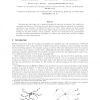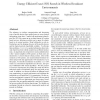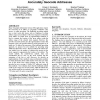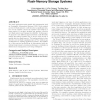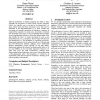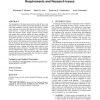100
click to vote
GIS
2004
ACM
15 years 18 days ago
2004
ACM
Moving point object data can be analyzed through the discovery of patterns. We consider the computational efficiency of detecting four such spatio-temporal patterns, namely flock,...
GIS
2004
ACM
15 years 18 days ago
2004
ACM
Recent growth of the geospatial information on the web has made it possible to easily access various maps and orthoimagery. By integrating these maps and imagery, we can create in...
GIS
2004
ACM
15 years 18 days ago
2004
ACM
GIS
2004
ACM
15 years 18 days ago
2004
ACM
The advances in wireless communication and decreasing costs of mobile devices have enabled users to access desired information at any time. Coupled with positioning technologies l...
GIS
2004
ACM
15 years 18 days ago
2004
ACM
Many Geographic Information System (GIS) applications require the conversion of an address to geographic coordinates. This process is called geocoding. The traditional geocoding m...
GIS
2004
ACM
15 years 18 days ago
2004
ACM
Despite various interoperability recommendations, heterogeneity of Geographic Information Systems (GIS) is still an issue. This led to an increasing need for a data integration sy...
GIS
2003
ACM
15 years 18 days ago
2003
ACM
For many applications with spatial data management such as Geographic Information Systems (GIS), block-oriented access over flash memory could introduce a significant number of no...
GIS
2003
ACM
15 years 18 days ago
2003
ACM
With the proliferation of mobile computing, the ability to index efficiently the movements of mobile objects becomes important. Objects are typically seen as moving in two-dimensi...
GIS
2003
ACM
15 years 18 days ago
2003
ACM
Advances in wireless communications, positioning technology, and other hardware technologies combine to enable a range of applications that use a mobile user's geo-spatial da...
GIS
2003
ACM
15 years 18 days ago
2003
ACM
